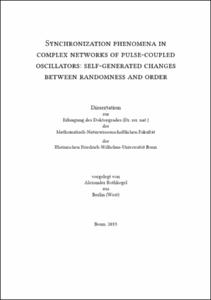Rothkegel, Alexander: Synchronization phenomena in complex networks of pulse-coupled oscillators: self-generated changes between randomness and order. - Bonn, 2014. - Dissertation, Rheinische Friedrich-Wilhelms-Universität Bonn.
Online-Ausgabe in bonndoc: https://nbn-resolving.org/urn:nbn:de:hbz:5n-35365
Online-Ausgabe in bonndoc: https://nbn-resolving.org/urn:nbn:de:hbz:5n-35365
@phdthesis{handle:20.500.11811/6056,
urn: https://nbn-resolving.org/urn:nbn:de:hbz:5n-35365,
author = {{Alexander Rothkegel}},
title = {Synchronization phenomena in complex networks of pulse-coupled oscillators: self-generated changes between randomness and order},
school = {Rheinische Friedrich-Wilhelms-Universität Bonn},
year = 2014,
month = mar,
note = {Complex network comprised of interconnected oscillatory systems are investigated in various contexts in the natural sciences. It is an important goal to understand in which way synchronization phenomena in such networks are determined by the structure of the network itself and by properties of the oscillatory systems. Contrasting the microscopic behavior which often shows fluctuations, many studies have characterized synchronization and desynchronization as convergence towards oscillatory and constant macroscopic behavior, respectively. However, very few models have been developed which show self-generated and recurrent changes between randomness and order.
In this thesis, we study the influence of the connection structure on the dynamical behavior of complex networks of oscillators. More concretely, we consider delta-pulse-coupled, excitatory integrate-and-fire-like oscillators, possibly endowed with refractory periods and time delayed interactions, and study their dynamics when coupled onto random and onto small-world networks, i.e., networks with both short-ranged and long-ranged connections.
In random networks, these oscillators may exhibit both chaotic, asynchronous behavior and synchronous behavior. We define and investigate different types of continuum models which describe the thermodynamic limit of large networks and allow us to characterize different mechanism for the loss of stability of asynchronous behavior. If stability is lost, oscillators may show partially synchronous states and irregular behaviors. We relate the latter to recurrent times at which the firing rate in the networks diverges and a macroscopic amount of oscillators spontaneously fires in unison.
Continuing one of these transitions to synchrony into the small-world regime leads to a rich spectrum of dynamical behaviors which are determined by the interplay between pattern formation and synchronization phenomena. In addition to various kinds of wave-dominated states, we report here on so-called chimera states, in which the networks split into asynchronous and synchronous regions. Depending on oscillator parameters, these regions may be fixed in shape and size, or may evolve constantly leading to macroscopic observables which show non-converging behavior. The latter may take the form of asynchronous firing interrupted by short and rare events of synchronous firing, or of a network rhythm in which more and less synchronous behaviors alternate on a timescale well below the period duration of oscillators.
The non-converging synchronization phenomena that we describe in this thesis add new aspects to the discussion which may help in unraveling the complicated relationships between the network structure, node dynamics, and the collective network dynamics.},
url = {https://hdl.handle.net/20.500.11811/6056}
}
urn: https://nbn-resolving.org/urn:nbn:de:hbz:5n-35365,
author = {{Alexander Rothkegel}},
title = {Synchronization phenomena in complex networks of pulse-coupled oscillators: self-generated changes between randomness and order},
school = {Rheinische Friedrich-Wilhelms-Universität Bonn},
year = 2014,
month = mar,
note = {Complex network comprised of interconnected oscillatory systems are investigated in various contexts in the natural sciences. It is an important goal to understand in which way synchronization phenomena in such networks are determined by the structure of the network itself and by properties of the oscillatory systems. Contrasting the microscopic behavior which often shows fluctuations, many studies have characterized synchronization and desynchronization as convergence towards oscillatory and constant macroscopic behavior, respectively. However, very few models have been developed which show self-generated and recurrent changes between randomness and order.
In this thesis, we study the influence of the connection structure on the dynamical behavior of complex networks of oscillators. More concretely, we consider delta-pulse-coupled, excitatory integrate-and-fire-like oscillators, possibly endowed with refractory periods and time delayed interactions, and study their dynamics when coupled onto random and onto small-world networks, i.e., networks with both short-ranged and long-ranged connections.
In random networks, these oscillators may exhibit both chaotic, asynchronous behavior and synchronous behavior. We define and investigate different types of continuum models which describe the thermodynamic limit of large networks and allow us to characterize different mechanism for the loss of stability of asynchronous behavior. If stability is lost, oscillators may show partially synchronous states and irregular behaviors. We relate the latter to recurrent times at which the firing rate in the networks diverges and a macroscopic amount of oscillators spontaneously fires in unison.
Continuing one of these transitions to synchrony into the small-world regime leads to a rich spectrum of dynamical behaviors which are determined by the interplay between pattern formation and synchronization phenomena. In addition to various kinds of wave-dominated states, we report here on so-called chimera states, in which the networks split into asynchronous and synchronous regions. Depending on oscillator parameters, these regions may be fixed in shape and size, or may evolve constantly leading to macroscopic observables which show non-converging behavior. The latter may take the form of asynchronous firing interrupted by short and rare events of synchronous firing, or of a network rhythm in which more and less synchronous behaviors alternate on a timescale well below the period duration of oscillators.
The non-converging synchronization phenomena that we describe in this thesis add new aspects to the discussion which may help in unraveling the complicated relationships between the network structure, node dynamics, and the collective network dynamics.},
url = {https://hdl.handle.net/20.500.11811/6056}
}






